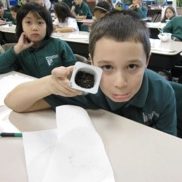(Level of difficulty **)
Question: do plants need light to germinate and grow?
Materials you will need:
•2 empty rinsed plastic yogurt containers or single-use cups (any size, preferably 3-10 oz)
•2 larger plastic or Styrofoam trays or bowls
•An awl
•Soil (dirt from outside should work)
•Seeds (bean, pea, cucumber, tomato, sunflower, corn, pumpkin or squash)
•Water (tap water is fine)•Aluminum foil
Directions:
•Poke small holes (1-3 per container) on the bottom of 2 containers or cups using an awl (have an adult help you with that!)
•Fill containers with soil and place them in a larger bowl/tray (to capture spills and leaks)
•Pour some water onto the soil to make it moist, but do not overwater (stop watering as soon as you see excess water coming out from the holes onto the tray)
•Put the seeds in soil (it is OK to put multiple seeds into each container, but keep the number of seeds in both containers the same) and cover them with a little bit of soil (finger-thick layer or less)
•Wrap one of the two containers with foil (it will block the light and keep the plants in the dark), leaving some space on the top of the container for the seeds to grow
•Put both containers next to the source of light (a windowsill).
•Wait for 3-14 days for the seeds to germinate. You can use the plant growing in the light as a clue of when to look at the dark-grown plants.
•Unwrap the pot with dark-grown plants and examine how it looks in comparison to the light-grown pot
Helpful hints and suggestions:
•Don’t forget to label the containers (for example, “dark” and “light”), so after your experiment is done you will not get confused which pot is which. •Dependent on what kind of seeds you planted and how fresh they are, it may take a very different amount of time for the seeds to germinate and grow.
•Dependent on what kind of seeds you planted and how fresh they are, it may take a very different amount of time for the seeds to germinate and grow.
•Don’t forget to water your plants! The easiest way to water the plants is to add water to the dish/tray your pots are sitting in: the soil and the plant roots will take up the water through the hole that you drilled!
Expected results:
•Seeds should germinate in both light- and dark-grown pots.
•The dark-grown seedlings typically grow a lot taller than light-grown ones (the ones in the dark continue to elongate in search for light)
•While light-grown seedlings turn green (due to the development of green chloroplasts that allow plants to capture light), the dark-grown seedlings remain yellow.
Follow-up questions:
•Why do you think plants need light?
•Why do plants grow taller in the dark?
•What would happen with your plants if you continued to grow them without light?
•What would happen if you took the foil cover off and moved dark-grown seedlings to light?
•If you were to repeat the experiment, would you get the same results?
•What would happen if you used another kind of seeds?





